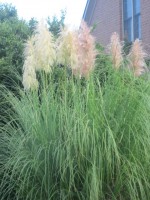
Native to Brazil, Argentina and Chile, this perennial grass is a member of the grass family, Poaceae, that also includes bamboo, rice, and corn. Plants form large clumps of arching, narrow silvery-gray/blue-green leaves with finely toothed margins. In August large blond to pink plumes appear above the the foliage and persist into winter adding movement and texture to the garden when most other plants are dormant. They look especially well placed against a dark background or where they can be back lit. Used as a specimen plants, hedge, or back of the border planting, pampas grass provided an architectural statement. Since the plants have razor sharp leaves, however, they should not be located on a walk or near a place where people are likely to brush up against them. They are vigorous plants and can become invasive so have been banned in some countries. Plumes are attractive in both fresh and dried arrangements. The genus name, Cortaderia, is from the Argentine-Spanish word cortadera meaning cutter and refers to the sharp leaf margins. The specific epithet, selloana, honors the German botanist and naturalist from Potsdam, Friedrich Sellow (1789-1831) who collected plants in Brazil.
Type: Perennial grass.
Bloom: Large (12” x 6’) silky blond or pink panicles that turn fluffy as they mature are borne above the foliage August through September.
Size: 12’ H x 6’ W clumps.
Light: Full sun; some light shade in South.
Soil: Prefers fertile, well-drained loamy soil but tolerates less.
Hardiness: Zones 7-10.
Care: Cut back in March to 2’.
Pests and Diseases: None of significance.
Propagation: Seeds (short viability) or division in spring or fall.
Companion plants: Best used as a specimen, in a group, or against a dark background.
Outstanding Selections:
-
- C. selloana ‘Pumila’ (dwarf; 3-6’ H)
-
- ‘Silver Stripe (white variegated)
- ‘Gold Band’ (yellow variegated)
